“It’s alright and it’s coming on / We gotta get it right back to where we started from” Maxine Nightingale, “Right Back Where We Started From”
Third-quarter results indicate that the post-COVID economic surge may be taking a pause, as stocks and bonds had a weak quarter and commodities, oil in particular, continued their strong rebound from 2020 and stoked inflation fears. The stock market’s proverbial ‘wall of worry’ has added a few new stones, some quite large, but we still see growth ahead and a good—but challenging—environment for stocks.
What added the new stones to the wall is a global economy flush with cash and enormous pent-up demand for goods and services that were affected by the COVID lockdown. While some industries and activities rebounded as expected, others have not, primarily in the leisure and travel segments of the economy. We also see some confusing data on how COVID relief funds were disbursed, as well as murky data on why and where people are either changing or not taking jobs. Anecdotal evidence abounds on the reasons for higher prices and high levels of unfilled jobs that have put a squeeze on employers. Add supply-chain issues and an inability to agree on necessary infrastructure and budget priorities in the U.S. as more stones in the wall, and we foresee some disruptive effects from higher inflation and yields and a correction for stocks in the next 12 to 18 months.
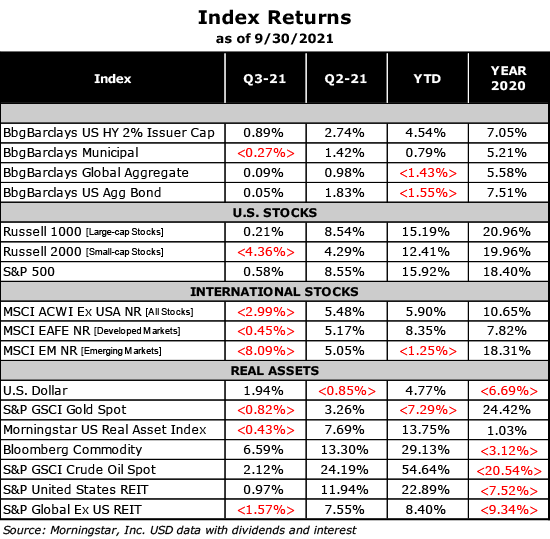
“Well, I won’t back down / No, I won’t back down / You can stand me up at the gates of hell / But I won’t back down” Tom Petty, “I Won’t Back Down”
It appears that the long-term effects of COVID-19 may translate to a broad endemic, a livable condition that will likely require vaccinations, boosters and other palliatives similar to those used to fight HIV. We know that a broad level of global COVID immunity will be an important step to managing the virus and moving forward to return to as much pre-COVID activity as possible. Two issues are hindering full recovery, one with respect to vaccination rates and the other with the disease itself.
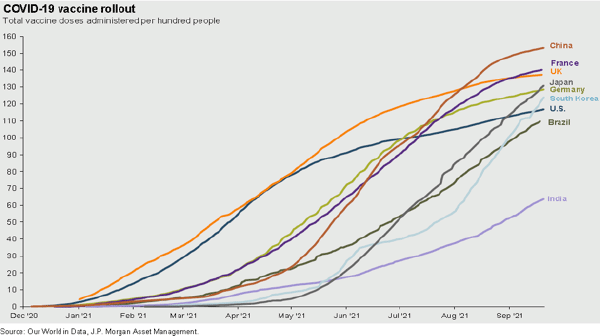
It is dismaying to find that the United States is not the global leader in vaccination rates. While the vaccine had a brief trial-review period, the severity of the crisis demanded a swift response. The U.S. is now lagging some key countries and may soon lag some emerging economies in vaccine rollout. Although the vaccines are not the proverbial magic bullet, they have reduced the worst effects of the virus and provided some relief to our stretched health-care systems.
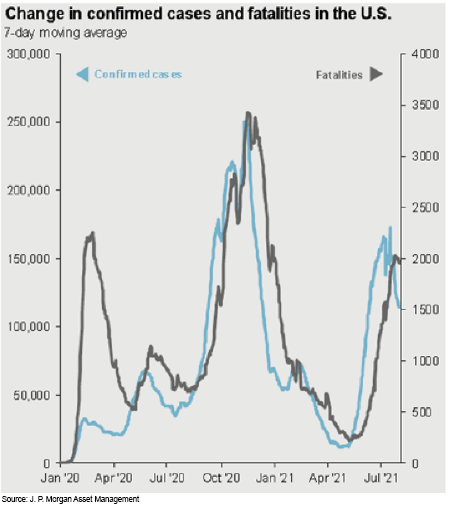
The second issue we see hampering a return to full social and economic activity is the presence of virus variants that have an exaggerated effect on society due to vaccine hesitancy and misinformation. Lack of taking enough preventative measures has promoted waves of new infections. The U.S. is experiencing its fourth wave now (right portion of graph) due to the more-virulent Delta variant, the fourth mutation of the original virus. The graph shows plummeting infection and fatality rates as various vaccines were rolled out in early 2021. As the graph above demonstrates, the marginal number of vaccinations began to decline in the summer, concurrent with increased social activity and the spread of Delta in the summer months. Data is also being studied on the emerging Lambda and Mu variants, though neither is a concern at this time. Vaccination shortfalls are causing predictions for a tough winter with the virus and common seasonal flu.
“I think a change / (A change would do you good) / Would do you good” Sheryl Crow, “A Change Would Do You Good”
It’s no surprise that the economy and markets have experienced strong—but expected—growth in the post-COVID recovery. The jobless rate has fallen, GDP growth has been very strong and asset markets have rewarded investors. The recovery has not been a global panacea, however, and as we noted above, the persistent coronavirus has pushed forward a number of social and economic issues that might derail future growth. They are specifically related to inflation, employment and the withdrawal of current levels of monetary and fiscal stimulus.
The following graph details the 50-year history of CPI (headline inflation) and the Fed’s preferred measure, the Personal Consumption Expenditure (PCE) deflator, which is generally lower than CPI:
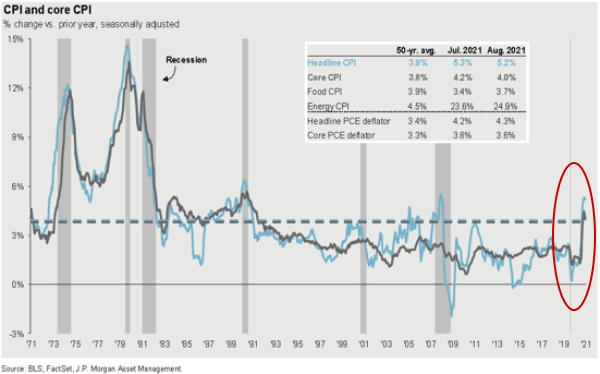
Very high readings in the 1970s skew the longer-term numbers, but we can see a definite uptick in the data above recent inflation trends. The Fed has indicated that they believe the inflation data we see are mostly transitory, and they’re willing to accept a higher run rate before beginning to hike rates. They have recently indicated that they see higher inflation for longer, and the level of ‘acceptable’ inflation and the Fed’s eventual hikes are what’s concerning markets now.
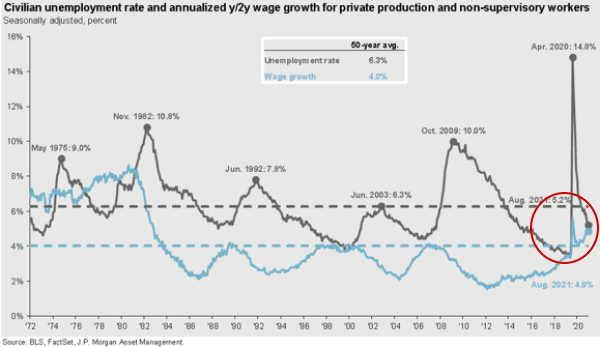
The other inflation issue that will have a deleterious effect on the economy is wage inflation. Although wage growth has been at or below 4% for many years, we can see a recent spike above that level. Normally this is an issue to be applauded, but adding wage demands to increasing difficulty in filling jobs and supply-chain issues portends increased prices and decreasing margins for companies in the months ahead.

As noted above, job creation is one of the phenomena contributing to inflation angst. The Dept. of Labor tracks open jobs data for its Job Openings and Labor Turnover Survey (JOLTS) report, seen here. The current reading of almost 11 million open positions far surpasses the previous high recorded in the Trump administration. Reasons for the high level of vacancies may include generous pandemic unemployment benefits, lack of universal benefits such as childcare, a desire for more hybrid work-from-home options and a willingness among jobseekers to change careers. A combination of these factors likely contributes to the data, but the expected effect is for higher wages and ultimately, some higher inflation as the JOLTS number declines. The recent cessation of extended unemployment benefits may offer some insight into the U.S. jobs recovery. Regardless of the causes for the high JOLTS data, Congress is expected to reduce fiscal stimulus in the coming months, adding another stone to the wall of worry.
“Tina, Tina, nobody else but Tina” Frank Sinatra, “Tina”
We have seen little to cause us to reconsider our belief in the TINA (‘there is no alternative’) trade favoring equities. Data now point to slowing growth in GDP and earnings in 2022, and we expect profit margins to come under pressure from supply-chain issues, inflation and the jobs issues previously discussed. An additional concern is that a form of stagflation may settle in the economy, in which growth slows considerably and inflation remains uncomfortably high. It’s too early to make that call, but the Fed is carefully watching the data and is expected to begin tapering its bond-buying program by the end of 2021. Modest interest-rate increases are now expected in the latter part of 2022. Indications are that fiscal stimulus will be gradually reduced as well, particularly if there is a change in the congressional majorities in 2022. All these factors point to higher volatility ahead for both stocks and bonds.
We are maintaining our view that taxable bonds, especially Treasuries and other government issues, are best regarded as a market-decline hedge rather than a robust source of income. We are also maintaining diversification in equities by allocating to smaller-cap and non-U.S. stocks to take advantage of some depressed valuations and participate in the breadth of the economic recovery.
Adjustments to portfolios and financial plans are best made in periods of relative calm. If your personal situation or perspective has changed in any way, we encourage you to contact us so we can determine if adjustments to your portfolio might be warranted for you.
As always, if you have any questions please feel free to contact us.
—Your Wealth Management Team at JJ Burns & Company
Download Market Commentary
Disclosure: J.J. Burns & Company, LLC is a registered investment adviser with the U.S. Securities & Exchange Commission and maintains notice filings with the States of New York, Florida Pennsylvania, New Jersey, Connecticut, Georgia, Illinois, North Carolina, and California. J.J. Burns & Company, LLC only transacts business in states where it is properly registered, or excluded or exempted from registration. Follow-up and individualized responses to persons that involves either the effecting or attempting to effect transactions in securities, or the rendering of personalized investment advice for compensation, as the case may be, will not be made absent compliance with state investment adviser and investment adviser representative registration requirements, or an applicable exemption or exclusion.
All investing involves risk, including the potential for loss of principal. There is no guarantee that any investment plan or strategy will be successful.
The foregoing content reflects the opinions of J.J. Burns & Company, LLC and is subject to change at any time without notice. Content provided herein is for informational purposes only and should not be used or construed as investment advice or a recommendation regarding the purchase or sale of any security. There is no guarantee that the statements, opinions or forecasts provided herein will prove to be correct.
Past performance may not be indicative of future results. Indices are not available for direct investment. Any investor who attempts to mimic the performance of an index would incur fees and expenses which would reduce returns.
Securities investing involves risk, including the potential for loss of principal. There is no assurance that any investment plan or strategy will be successful.


